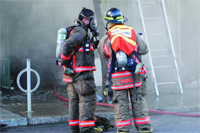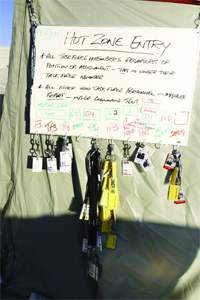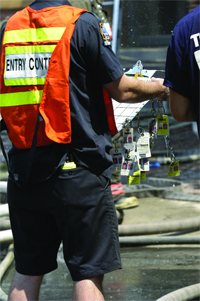
Features
Training
Incident Command System
The evolution of effective communication puts all responding agencies on same page at major incidents in Canada and U.S.
April 28, 2008
By James Careless
On March 25, a runaway freight car loaded with lumber crashed into a commuter train carrying 300 passengers in Massachusetts. The emergency response to the chaos involved dozens of agencies, all trained in the incident command system or ICS.
“Everyone was delegated an authority, and it was agreed to in the command post,” Fire Chief Thomas J. Ronayne III told www.boston.com. “Everyone knew what the action plan was, and they knew what their responsibilities would be.”
According to boston.com, Amtrak officials shut off power to the tracks. Police barricaded streets and established security. State police sent a helicopter to monitor the tracks and emergency medical crews established communications channels with hospitals.
 |
| A Toronto firefighter checks in with an entry control officer while putting on air before entering a working fire at a two-alarm response on Queen Street East. PHOTO BY JOHN RIDDELL |
Within 65 minutes of the first emergency calls, 123 people had been taken to hospitals, and within 95 minutes the train and surrounding area were checked three times for any last victims, the botson.com website reported.
“If you were to lay the plan out, this was the way the incident played out,” Chief Ronanyne said. “All the training we had done came to work.”
Adopted by the U.S. Department of Homeland Security as its national standard for first responder incident scene management, and widely used in Canada as well, ICS is “an all-hazards approach to any kind of critical incident management,” says Richard Smith, an ICS instructor with the Emergency Response Institute Canada (www.ericanada.com ) in Calgary.
“ICS defines a standard command-and-control structure for incident scenes that covers fire, police, and EMS,” he says. “It lays out common terminology and practices for everyone to follow, so that there’s no confusion at the scene.”
In other words, “ICS ensures that we are all working from the same page,” says Roger Gibson, regional co-ordinator for the Office of Emergency Preparedness at Alberta’s CapitalCare.
This said, the current ICS approach have some limits. In particular, ICS does not always include natural gas, water and local electrical commissions, says Greg Solecki. senior business continuity and emergency management planner of water services/water resources for Calgary’s Department of Utilities & Water Protection. “This means that they are left out at mutual-aid incidents, causing the exact kinds of problems that ICS is meant to address.”
 |
| The Incident Command System was used effectively at a mock disaster exercise in Toronto in November. PHOTO BY JOHN HANLEY |
The history of ICS
During 13 days in 1970, wildfires in California killed 16 people, destroyed 700 structures, and burned half a million acres of land. In the post mortem that followed the disaster, it became clear that problems in inter-agency communications and co-ordination had made matters worse. As a result, the U.S. Congress ordered the U.S. Forest Service to "make a quantum jump in the capabilities of southern California wildland fire-protection agencies to effectively co-ordinate interagency action and to allocate suppression resources in dynamic, multiple-fire situations.”
The result was FIRESCOPE (Firefighting Resources of California Organized for Potential Emergencies). In 1973, FIRESCOPE started work on an integrated command-and-control approach, which evolved into ICS.
By 1981 ICS was in widespread use by southern California fire departments. Eventually, the ICS was harmonized with the Fire Ground Command System developed by the Phoenix Fire Department, with additional work being done in a unified fashion by U.S. firefighting agencies. By the 1990s, the result of their efforts was the National Incident Management System (NIMS), which has since been mandated by Homeland Security as the U.S. national incident command standard with ICS as an integral part.
“ICS began to be used by Canadian agencies in the early 1990s,” says Roger Gibson. “The B.C. government was the first to adopt it as standard operating procedure mid-decade, with other provinces following suit since then.”
How ICS works
Simply describing ICS as a unified command-and-control incident management system is like calling Wayne Gretzky a great hockey player. Both statements are true, but woefully lacking in detail.
 |
| PIT passes hang from the entry control board during a four-alarm fire in Toronto. There were more than 80 personnel on scene and more than a dozen firefighters coming and going inside two dwellings. PHOTO BY JOHN RIDDELL |
In the case of ICS, the system is really a philosophical and strategic approach to incident management in all its aspects. Recognizing that a unified command works best to prevent confusion and minimize risk to first responders, ICS defines who is in charge and which specific responsibilities each responding agency has at the scene. ICS also specifies the terminology to be used by everyone present, and the ways in which they must work together in varying circumstances. In addition, the ICS approach covers the importance of establishing “incident action plans” before things happen, so that everyone knows exactly how they are to work together when trouble does occur. Also dealt with are integrated communications, pre-designated incident mobilization center locations and facilities, deployment and information and intelligence management.
Again, even this description isn’t enough either to fully explain ICS, or to teach it effectively. It is for this reason that ERI Canada, Greg Soloecki, and many other organizations offer ICS courses to first responders. Designed to be taught in the span of a few days or less, these courses walk responders not just through the philosophy and details of ICS, but get their brains into it through tabletop exercises where scenarios are laid out for them to solve.
“There are four levels of ICS courses, and depending on your jurisdiction, you may find yourself taking two or more of them,” says Gibson.
ICS-100 provides an introduction to the Incident Command System, laying out the basics of ICS and preparing first responders for further education.
ICS-200 takes this theory and applies it to ‘single resource and initial action incidents’, Gibson says, the kind of basic events that most rural and small departments deal with regularly. In many cases, he says, this is all the classroom learning many first responders require.
According to Solecki, ICS-300 is an intermediate course that teaches responders how to work in multi-agency response situations where the ICS command system is in full deployment.
Finally, ICS-400 is the most complex course aimed at people who may face 9-11 type situations. This is high-end ICS training for large departments and those in sensitive locales.
The importance of real-life training
The tabletop exercises that take place in ICS classrooms give first responders a chance to take what they’ve learned and apply it to act-ual scenarios; sitting and talking with fellow students to find the best solutions within an ICS-style approach. However, nothing can substitute for real-life ICS field exercises, where participating agencies apply their classroom-acquired knowledge to physical locations, instructor-imposed scenarios, and volunteer ‘victims’ (members of the public who look like and act like seriously-injured casualties).
“For ICS to succeed, you really have to get people using it in the real world,” says Roger Gibson. “ICS-based field exercises face people with the kinds of problems they deal with at true-life incidents. Besides, they force commanders to park their egos, and to get accustomed to the idea of doing so during multi-agency situations.”
ICS was used in Toronto in November at a mock-disaster exercise comprising almost 1,000 members of urban search and rescue teams and provincial and federal medical units. It became clear early on that although the system worked almost flawlessly for the highly trained USAR teams and other fire services personnel, other responders need to learn and embrace the system in order for it to work at major incidents.
Current limits
All three of the Canadian experts agree that ICS is making a difference today, by improving inter-agency co-operation and functioning at mutual aid incidents. But there is more that could be done, says Greg Solecki.
“Successful incident response doesn’t just require fire, EMS, and police to work together; you also need the people who control the gas lines, hydro, and water to be in the loop to do things right,” he says.
“Sadly, a lot of ICS-driven bodies still don’t understand that everyone who might turn up at an incident needs to be up to speed on ICS. They need to bring in utilities and indeed any other agency that might turn up at an incident scene, for ICS to
work fully.”
This notwithstanding, ICS remains the best apparent solution to the challenge of inter-agency command-and-control. This is why Homeland Security has embraced ICS as part of its NIMS, and why ICS continues to gain traction among Canadian agencies and governments too.
Print this page